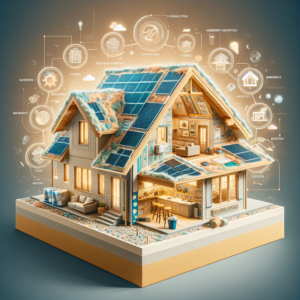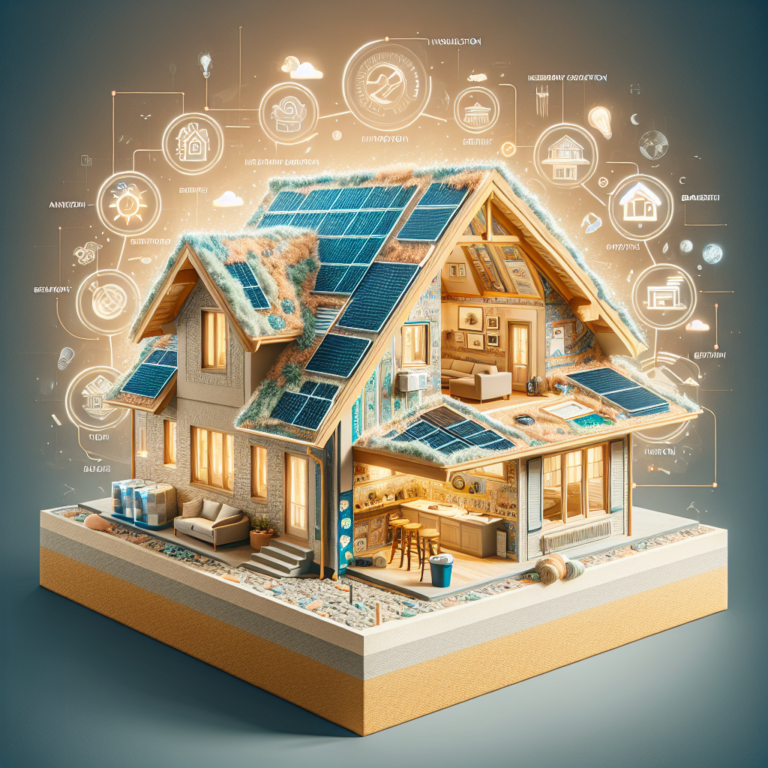-
Table of Contents
“Insulate for a greener future – reduce your carbon footprint today!”
“Reduce your carbon footprint and save on energy costs by investing in proper insulation for your home. Visit texasinsulationsolution.com to learn more and take action towards a more sustainable future.”
Introduction
Insulation is a crucial aspect of reducing carbon footprint and promoting sustainability. It refers to the materials and techniques used to prevent heat transfer between the interior and exterior of a building, ultimately reducing the amount of energy needed for heating and cooling. By improving insulation in buildings, we can significantly decrease the amount of greenhouse gas emissions and energy consumption, thus contributing to the reduction of our carbon footprint. In this way, insulation plays a vital role in promoting environmental responsibility and mitigating the effects of climate change.
The Impact of Proper Insulation on Reducing Carbon Footprint
Insulation is a crucial aspect of any building, whether it is a residential home or a commercial space. It is responsible for keeping the interior temperature comfortable and reducing energy consumption. However, insulation also plays a significant role in reducing carbon footprint, making it an essential factor to consider in the construction and maintenance of any structure.
Carbon footprint refers to the amount of carbon dioxide and other greenhouse gases emitted by an individual, organization, or product. These emissions contribute to climate change and have a detrimental impact on the environment. As the world becomes more aware of the need to reduce carbon footprint, it is essential to understand how proper insulation can help in this effort.
One of the primary ways in which insulation reduces carbon footprint is by reducing energy consumption. Insulation acts as a barrier between the interior and exterior of a building, preventing heat from escaping during the winter and entering during the summer. This means that less energy is required to heat or cool the building, resulting in lower carbon emissions from power plants.
In addition to reducing energy consumption, proper insulation also helps in reducing the use of fossil fuels. Fossil fuels, such as coal, oil, and natural gas, are the primary sources of energy for heating and cooling buildings. However, the extraction and burning of these fuels release large amounts of carbon dioxide into the atmosphere, contributing to climate change. By reducing the need for heating and cooling, insulation reduces the demand for fossil fuels, thus reducing carbon emissions.
Moreover, insulation also has a direct impact on the materials used in construction. Traditional insulation materials, such as fiberglass and foam, are made from non-renewable resources and have a high carbon footprint. On the other hand, newer and more sustainable insulation materials, such as cellulose and recycled denim, have a lower carbon footprint. By using these sustainable materials, the overall carbon footprint of a building can be significantly reduced.
Another way in which proper insulation can help in reducing carbon footprint is by increasing the lifespan of a building. Insulation not only keeps the interior temperature comfortable but also protects the building from external elements. This means that the building will require less maintenance and repairs, resulting in a longer lifespan. As a result, fewer resources will be needed for the construction of new buildings, reducing the carbon footprint of the construction industry.
Furthermore, proper insulation also has a positive impact on indoor air quality. Insulation helps in keeping out pollutants and allergens, creating a healthier and more comfortable living or working environment. This means that occupants will be less likely to use energy-consuming air purifiers or air conditioners, resulting in lower carbon emissions.
It is also worth mentioning that proper insulation can help in reducing the carbon footprint of transportation. As buildings become more energy-efficient, the demand for energy from power plants decreases. This, in turn, reduces the need for transportation of fossil fuels, which is a significant contributor to carbon emissions.
In conclusion, proper insulation has a significant impact on reducing carbon footprint. By reducing energy consumption, decreasing the use of fossil fuels, and promoting the use of sustainable materials, insulation plays a crucial role in mitigating climate change. As individuals and organizations strive to reduce their carbon footprint, it is essential to consider the role of insulation in achieving this goal. Investing in proper insulation not only benefits the environment but also results in cost savings and a more comfortable living or working space.
Maximizing Energy Efficiency through Insulation Techniques
Insulation is a crucial aspect of maximizing energy efficiency in buildings. It plays a significant role in reducing the carbon footprint of a structure, making it an essential consideration for both residential and commercial buildings. In this article, we will explore the relationship between insulation and carbon footprint reduction, and how proper insulation techniques can help in achieving energy efficiency.
First and foremost, it is essential to understand what a carbon footprint is and how it relates to buildings. A carbon footprint is the total amount of greenhouse gas emissions produced by an individual, organization, or product. Buildings are responsible for a significant portion of global carbon emissions, with heating and cooling being the primary contributors. This is where insulation comes into play.
Insulation is the process of adding a material to a building’s structure to reduce heat transfer. It acts as a barrier, preventing heat from escaping during the winter and entering during the summer. By reducing the need for heating and cooling, insulation helps in reducing the energy consumption of a building, thus lowering its carbon footprint.
One of the main benefits of insulation is its ability to reduce the use of fossil fuels. Fossil fuels, such as coal, oil, and natural gas, are the primary sources of energy for heating and cooling buildings. These fuels emit large amounts of carbon dioxide when burned, contributing to the greenhouse effect and climate change. By reducing the need for heating and cooling, insulation helps in reducing the demand for fossil fuels, thus lowering carbon emissions.
Moreover, insulation also helps in reducing the energy consumption of a building. According to the U.S. Department of Energy, heating and cooling account for about 48% of the energy use in a typical home. By properly insulating a building, the need for heating and cooling is reduced, resulting in lower energy consumption. This not only helps in reducing the carbon footprint of a building but also leads to cost savings for the building owner.
Another significant benefit of insulation is its ability to improve indoor air quality. Insulation helps in sealing air leaks, preventing outdoor pollutants from entering the building. This is especially important in urban areas where air pollution is a major concern. By improving indoor air quality, insulation contributes to a healthier and more comfortable living environment.
Furthermore, insulation also helps in reducing the strain on the power grid. During peak energy demand, power plants often have to use less efficient and more polluting methods to meet the increased demand. By reducing the energy consumption of buildings, insulation helps in reducing the strain on the power grid, thus lowering carbon emissions from power plants.
When it comes to insulation techniques, there are various options available, each with its own benefits and considerations. The most common types of insulation include fiberglass, cellulose, and spray foam. Fiberglass is the most widely used type of insulation and is relatively inexpensive. Cellulose is made from recycled materials and is a more environmentally friendly option. Spray foam, on the other hand, provides the highest level of insulation but is also the most expensive.
In addition to choosing the right type of insulation, proper installation is crucial for maximizing its effectiveness. Insulation should be installed correctly and without any gaps or voids to ensure maximum energy efficiency. It is recommended to hire a professional insulation contractor to ensure proper installation.
In conclusion, insulation plays a crucial role in reducing the carbon footprint of buildings. By reducing the need for heating and cooling, insulation helps in lowering energy consumption, reducing the use of fossil fuels, and improving indoor air quality. With the various insulation options available, it is essential to choose the right type and ensure proper installation for maximum energy efficiency. By incorporating insulation into building design and construction, we can make significant strides in reducing our carbon footprint and creating a more sustainable future.
Insulation: A Key Factor in Achieving a Greener Home and Reducing Carbon Footprint
Insulation is a crucial element in creating a greener home and reducing our carbon footprint. It is a simple yet effective way to make our homes more energy-efficient and environmentally friendly. In this article, we will explore the importance of insulation and how it can contribute to reducing our carbon footprint.
First and foremost, let us understand what insulation is and how it works. Insulation is a material that is used to prevent the transfer of heat between the inside and outside of a building. It acts as a barrier, keeping the warm air inside during the winter and the cool air inside during the summer. This means that less energy is needed to maintain a comfortable temperature inside the house, resulting in lower energy consumption and reduced carbon emissions.
One of the main benefits of insulation is its ability to reduce the amount of energy needed to heat or cool a home. According to the U.S. Department of Energy, heating and cooling account for nearly half of the energy used in a typical home. By properly insulating our homes, we can significantly reduce this energy consumption, leading to a decrease in our carbon footprint.
Insulation also plays a crucial role in reducing the amount of greenhouse gases emitted into the atmosphere. When we use less energy to heat or cool our homes, we are also reducing the demand for fossil fuels, which are the primary source of these harmful gases. By reducing our carbon footprint, we are contributing to the fight against climate change and creating a more sustainable future for generations to come.
Moreover, insulation not only benefits the environment but also our wallets. By reducing our energy consumption, we can save money on our utility bills. According to the Environmental Protection Agency, homeowners can save an average of 15% on heating and cooling costs by properly insulating their homes. This means that insulation not only helps us reduce our carbon footprint but also helps us save money in the long run.
Another important aspect to consider is the type of insulation used in our homes. There are various types of insulation available, such as fiberglass, cellulose, and spray foam. Each type has its own benefits and drawbacks, but the key is to choose the most suitable one for our homes. For example, spray foam insulation has a higher R-value (a measure of insulation’s ability to resist heat flow) than other types, making it more effective in reducing energy consumption. However, it is also more expensive than other options. It is essential to consult a professional to determine the best type of insulation for our homes.
In addition to the type of insulation, the location and amount of insulation are also crucial factors to consider. Insulation should be installed in all areas of the house, including the walls, attic, and floors. The more insulation we have, the better it will be for reducing our carbon footprint. It is also essential to ensure that there are no gaps or spaces in the insulation, as this can reduce its effectiveness.
In conclusion, insulation is a key factor in achieving a greener home and reducing our carbon footprint. It not only helps us save money on our utility bills but also contributes to the fight against climate change. By properly insulating our homes, we can significantly reduce our energy consumption and greenhouse gas emissions. It is a simple yet effective way to make a positive impact on the environment and create a more sustainable future. So, let us all make the necessary changes and insulate our homes to reduce our carbon footprint and protect our planet.
Q&A
1) What is insulation and how does it help reduce carbon footprint?
Insulation is a material used to prevent the transfer of heat or sound between two areas. It helps reduce carbon footprint by improving the energy efficiency of buildings. By properly insulating a building, less energy is needed to heat or cool the space, resulting in lower carbon emissions from energy production.
2) What are some common types of insulation?
Some common types of insulation include fiberglass, cellulose, foam board, and spray foam. Each type has its own unique properties and benefits, and the best type for a specific project will depend on factors such as budget, location, and desired level of insulation.
3) How can individuals and businesses incorporate insulation into their carbon footprint reduction efforts?
Individuals and businesses can incorporate insulation into their carbon footprint reduction efforts by ensuring that their homes and buildings are properly insulated. This can include adding insulation to walls, attics, and crawl spaces, as well as sealing any air leaks. Additionally, choosing energy-efficient insulation materials and regularly maintaining and upgrading insulation can also help reduce carbon footprint.
Conclusion
In conclusion, insulation plays a crucial role in reducing carbon footprint. By properly insulating buildings, we can reduce the amount of energy needed for heating and cooling, thereby decreasing the carbon emissions from power plants. Additionally, insulation can also help to reduce the use of fossil fuels and promote the use of renewable energy sources. It is a simple and effective way to make a positive impact on the environment and reduce our carbon footprint. Therefore, investing in insulation is not only beneficial for our wallets, but also for the planet.








